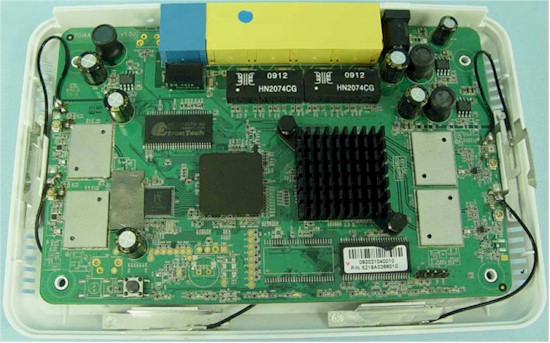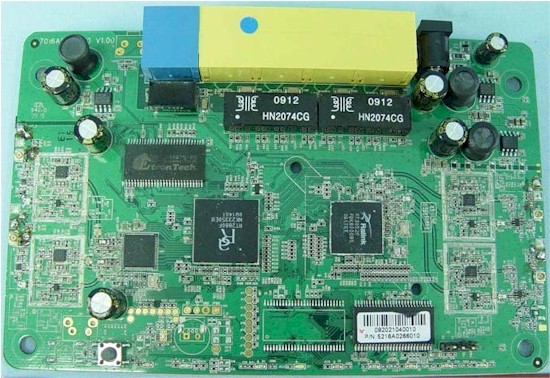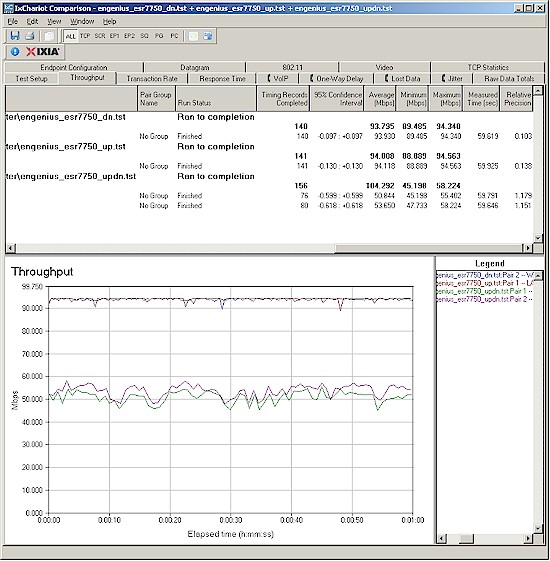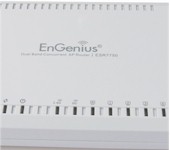 Updated 5/24/2010 – The EnGenius ESR7750 300Mbps Dual-Band Wireless N Router has been added to the Router and Wireless Charts.
Updated 5/24/2010 – The EnGenius ESR7750 300Mbps Dual-Band Wireless N Router has been added to the Router and Wireless Charts.
The ESR7750 is a dual-band, dual-radio, dual-cpu Ralink-based 802.11n router with WDS bridging / repeating and up and download bandwidth control.
Its feature set is essentially the same as its single band sibling, the ESR9850. Refer to that review for a rundown of the tricks that the 7750 can do, which include four SSIDs, each with separate wireless security and support for WDS bridging and repeating.
The figure below shows what the 7750 looks like opened up. The dual-CPU design uses two Ralink SoCs, the RT3052F, which also powers the ESR9850, and an RT2880F.
EnGenius ESR7750 Internal view
The view below with the heatsinks removed shows the RT2880F on the left and the RT3052F on the right. Note that the production sample that EnGenius provided for review used two of the same, simpler ceramic slab heatsinks like the one on the left in the photo.
The 3052F provides the 2.4 GHz band radio and also the four-port 10/100 switch and 10/100 WAN port. The 2880F, joined with a Ralink RT2850L 5 GHz 2T3R transceiver, supports the 5 GHz radio. Even though the 5 GHz radio is a 2 Transmit, 3 Receive design, only two internal antennas are attached to each radio, as shown in the photo above.
EnGenius ESR7750 board detail
You can see the two RAM chips in the photo, but the two flash devices are on the bottom of the board. The 3052F gets 32 MB of RAM and 8 MB of flash, while the 2880F has only 16 MB of RAM and 2 MB of flash. There are no USB ports in this design, so printer and drive sharing isn’t possible.
Routing throughput measured 94 Mbps WAN to LAN, 94 Mbps LAN to WAN and 104 Mbps with both directions running simultaneously. So the 10/100 ports are probably limiting the routing throughput delivered to essentially 100 Mbps wire speed. The IxChariot plot below shows nice steady routing speed.
EnGenius ESR7750 routing throughput
Our new Maximum Simultaneous Connection test came in at 2,038, which was below expectations and a new low for routers tested with the new procedure. (see update below) EnGenius said that the 1.1.2 firmware (Release Date: 1/12/2010) that we freshly downloaded and flashed should have provided a session limit around 20,000. But we were not able to verify this claim after repeated tests.
Updated 5/24/2010
Router was retested with newly-released 1.1.3 firmware (1-1-3-75 kernel / 1-1-3-50 app, Release Date: 5/18/2010), which EnGenius said raised the session limit to 30,000. Our test maxed out at 42, 579 connections with the 1.1.3 firmware.
Wireless performance was disappointing, with the weakest 2.4 GHz performance we’ve experienced in awhile. Connection in our low signal test locations E and F was iffy, not just in 40 MHz mode, but also in 20 MHz—something we haven’t seen since we started using the Intel WiFi Link 5300 test client.
It took multiple runs to get the 2.4 GHz uplink test to run in 20 MHz bandwidth mode and it failed to make it at all in 40 MHz bandwidth mode. The results for both bands are summarized in the chart below.
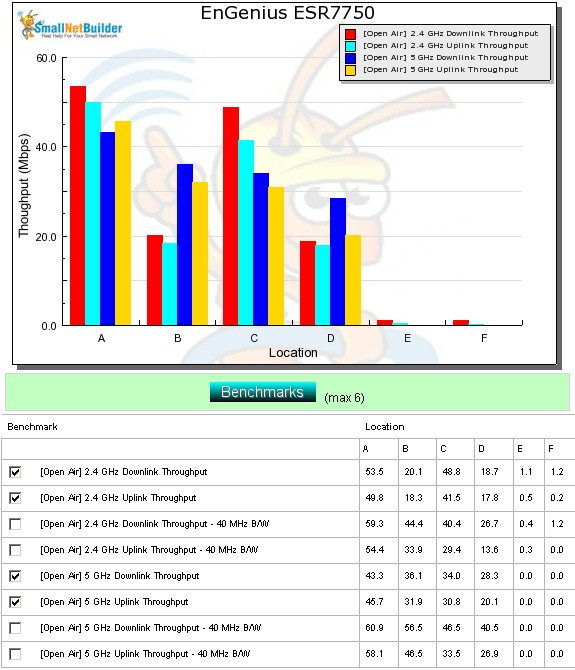
EnGenius ESR7750 wireless performance summary
A scan of the chart above shows that best case throughput was only 60.9 Mbps (5 GHz band, 40 MHz bandwidth, Location A). We were able, however, to get around 74 Mbps of total throughput when running simultaneous single up and downlink streams on either radio when using 40 MHz bandwidth mode.
Here are links to the IxChariot wireless test plots if you’d like to explore further:
- 2.4 GHz / 20 MHz downlink
- 2.4 GHz / 20 MHz uplink
- 2.4 GHz / 20 MHz up and downlink
- 2.4 GHz / 40 MHz downlink
- 2.4 GHz / 40 MHz uplink
- 2.4 GHz / 40 MHz up and downlink
- 5 GHz / 20 MHz downlink
- 5 GHz / 20 MHz uplink
- 5 GHz / 20 MHz up and downlink
- 5 GHz / 40 MHz downlink
- 5 GHz / 40 MHz uplink
- 5 GHz / 40 MHz up and downlink
Keep in mind that the 7750 is not Wi-Fi Certified and it defaults to Auto 20/40 bandwidth mode in 2.4 GHz instead of 20 MHz bandwidth mode, in violation of the 802.11n "out of the box" spec. It did, however, properly limit link rate to 54 Mbps when using WEP and WPA / TKIP wireless security. And a Wi-Fi Protected Setup (WPS) test using PIN mode, properly resulted in a WPA2 / AES connection.
Since the ESR7750‘s feature set is the same as the ESR9850, we won’t be doing a full review. Use the Router and Wireless Charts to compare it to other products.

